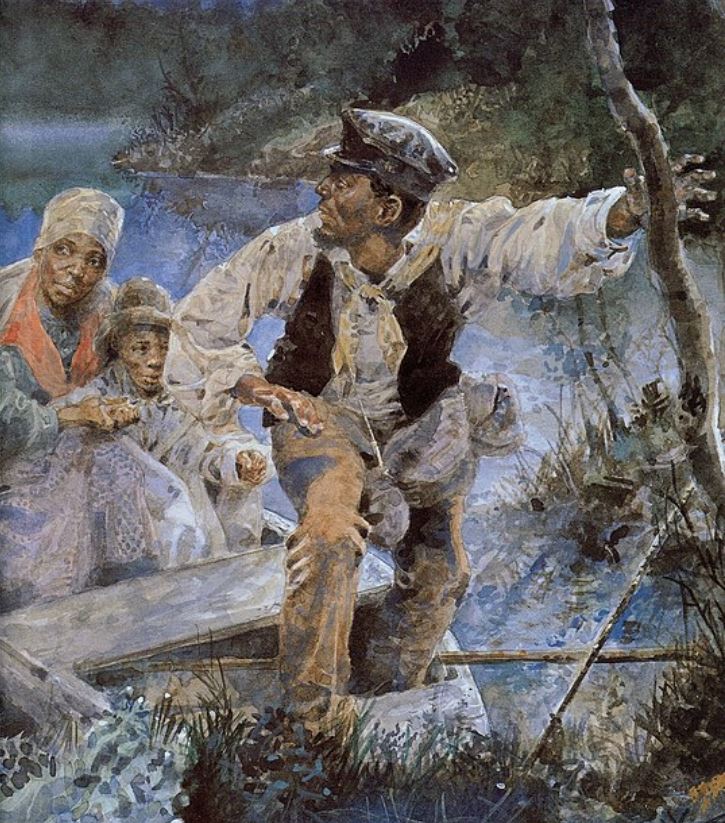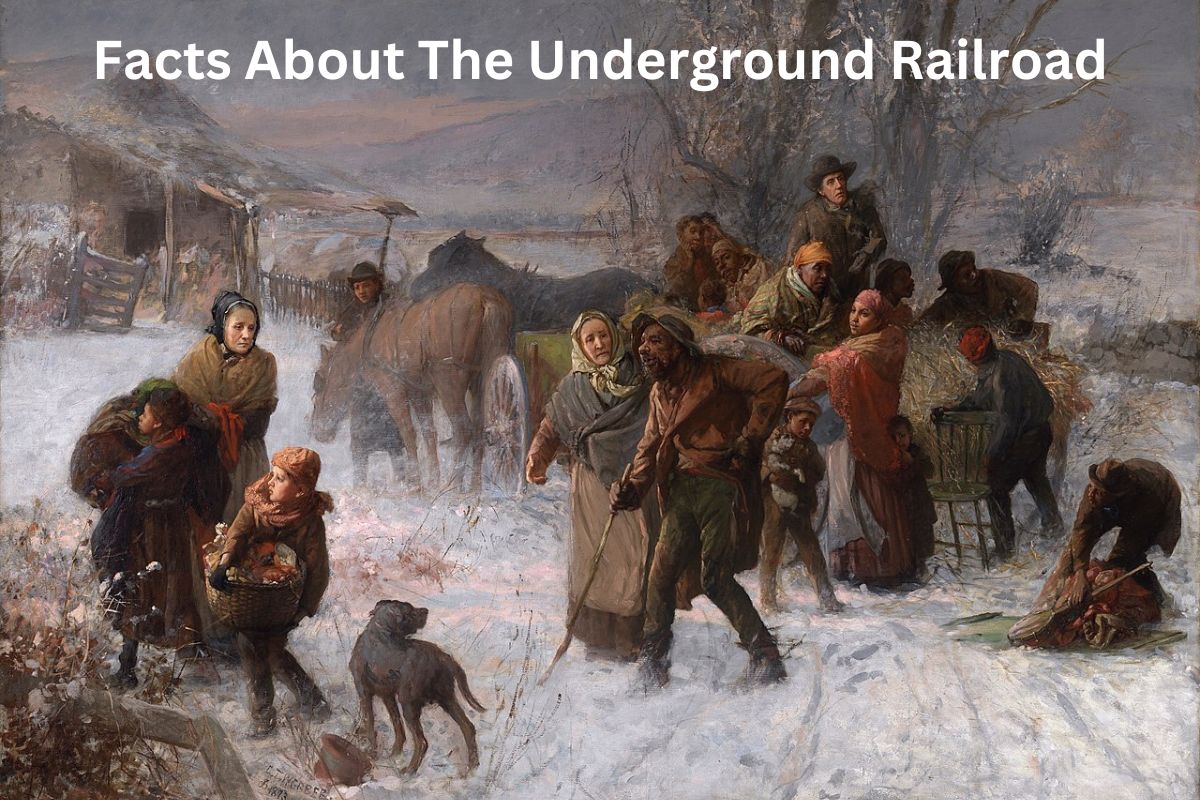The Underground Railroad was not a physical railroad, but rather a covert network of routes, safe houses, and individuals who facilitated the escape of enslaved African Americans from the Southern states to freedom in the North and Canada during the 19th century.
The term “Underground” emphasized its clandestine nature, while “Railroad” metaphorically described the system of transportation and support. Operating from the late 18th century to the Civil War era, the Underground Railroad played a pivotal role in helping thousands of enslaved individuals seek liberation.
This remarkable movement, marked by courageous conductors, safe houses, and coded communication, defied the oppressive institution of slavery and became a symbol of resistance and hope.
Its legacy endures as a testament to the power of collective action, compassion, and determination in the pursuit of justice and equality.
Underground Railroad Facts
1. The Underground Railroad was not an actual railroad
The Underground Railroad was not an actual railroad. It was a metaphorical term used to describe the secret network of routes, safe houses, and individuals that facilitated the escape of enslaved African Americans from the Southern states to freedom in the North and Canada.
The name “Underground” emphasized the clandestine nature of the operation, while “Railroad” suggested a system of transportation.
2. The Underground Railroad operated primarily in the United States during the 19th century
The Underground Railroad was most active during the 19th century, particularly from the late 18th century to the Civil War era.
While efforts to help enslaved individuals escape had been taking place since the colonial period, the network expanded and became more organized during the early 1800s.
Also Read: The Underground Railroad Timeline
It reached its peak in the 1850s when the Fugitive Slave Act was passed, making it even more dangerous for escaped slaves.

3. Harriet Tubman, often referred to as the “Moses of her people,” was one of the most famous conductors of the Underground Railroad
Harriet Tubman is perhaps the most well-known conductor of the Underground Railroad. Born into slavery herself, Tubman escaped to freedom in 1849 but returned numerous times to the South to guide others to freedom.
She made an estimated 19 trips and helped rescue approximately 300 enslaved individuals, including family members and friends. Tubman’s courage, determination, and intimate knowledge of the terrain made her an effective leader and symbol of resistance.
4. The term “Underground Railroad” is believed to have originated around 1831
The term “Underground Railroad” is believed to have originated around 1831, although its exact origins are unclear. It is commonly attributed to Tice Davids, an enslaved man who successfully escaped from Kentucky to Canada.
When asked about his escape, he reportedly referred to it as “taking the underground road.” The term caught on and was subsequently used to describe the secret network of escape routes.
5. The Underground Railroad had a decentralized and secretive nature
The Underground Railroad operated in a decentralized and secretive manner. It had no central organization or leadership. Instead, it relied on a vast network of individuals, both black and white, who sympathized with the cause of abolition and were committed to helping enslaved people escape.
Conductors were key figures who guided freedom seekers along the route, using their knowledge of the landscape and connections with safe houses along the way.
The secretive nature of the operation was essential to protect both those seeking freedom and those assisting them, as it reduced the risk of infiltration and discovery by slave catchers.
6. Conductors were individuals who guided enslaved people along the Underground Railroad
Conductors played a vital role in the Underground Railroad. They were individuals who actively assisted freedom seekers in navigating the network and reaching their destinations safely.
Conductors were often former slaves or sympathetic individuals who had knowledge of the routes, safe houses, and the dangers involved.
They used various methods to communicate and coordinate, including coded language, symbols, and signals. For example, songs like “Follow the Drinking Gourd” contained hidden messages and directions to guide escapees.
7. Safe houses, also known as “stations” or “depots,” were places where enslaved individuals could rest, receive food and shelter
Safe houses, also known as “stations” or “depots,” were essential components of the Underground Railroad.
These were places where freedom seekers could find temporary refuge, rest, receive food, and receive assistance before continuing their journey to the next safe location.
Safe houses were typically operated by sympathetic individuals or families who were committed to helping escaped slaves. These places provided crucial support and protection along the often treacherous and arduous journey to freedom.
8. Many people involved in the Underground Railroad were Quakers
While the Underground Railroad had a diverse range of participants, including Quakers, ministers, and free African Americans, the Quaker community played a significant role in the movement.
The Quakers, also known as the Society of Friends, strongly opposed slavery on moral and religious grounds. Their beliefs in equality and justice led many Quakers to actively participate in the Underground Railroad.
Their involvement ranged from offering safe houses and financial support to organizing anti-slavery societies and aiding in legal battles against slavery.
9. The Underground Railroad extended to both northern states and Canada
The Underground Railroad extended to both the northern states of the United States and Canada. While some freedom seekers opted to settle in free states, others continued their journey to Canada, where slavery had been abolished in 1834.
Canada provided a more secure and permanent refuge for those seeking freedom. The country’s proximity to the northern states and the absence of slavery made it an attractive destination for many escaping slaves.
10. Slave catchers and bounty hunters were a constant threat to those using the Underground Railroad
The presence of slave catchers and bounty hunters posed constant threats to those involved in the Underground Railroad. These individuals were hired to track down and capture escaped slaves, often with substantial financial rewards.
The Fugitive Slave Act of 1850 intensified the dangers faced by freedom seekers and those assisting them. The law required citizens, even in free states, to cooperate in the capture and return of escaped slaves. It also imposed harsh penalties on anyone caught aiding or harboring fugitive slaves.
These risks forced Underground Railroad participants to operate discreetly and maintain secrecy to protect the lives and freedom of all involved.
11. The Fugitive Slave Act of 1850, part of the Compromise of 1850, posed significant challenges to the Underground Railroad
The Fugitive Slave Act of 1850 was a crucial turning point for the Underground Railroad. The law was part of the Compromise of 1850, intended to maintain a delicate balance between free and slave states.
Also Read: Fugitive Slave Act Facts
The act mandated the return of escaped slaves to their owners, even if they had reached free states. It required citizens to assist in capturing and returning runaway slaves and imposed severe penalties, including fines and imprisonment, for those who aided in their escape.
The Fugitive Slave Act heightened tensions between abolitionists and pro-slavery advocates and further motivated the efforts of the Underground Railroad to help enslaved individuals escape to Canada and other safe locations.
12. It is estimated that between 30,000 and 100,000 enslaved individuals escaped to freedom through the Underground Railroad
Estimates of the number of individuals who escaped slavery through the Underground Railroad vary, but it is believed that between 30,000 and 100,000 enslaved people found their way to freedom during its operation.
While this number represents a fraction of the millions held in bondage, the impact of the Underground Railroad extended far beyond the actual number of escapees.
The stories of successful escapes and the knowledge that there was a network of support and resistance against slavery inspired hope and encouraged others to resist the institution.
13. The Underground Railroad played a crucial role in raising awareness about the cruelty and injustice of slavery
The Underground Railroad played a significant role in raising awareness about the inhumane nature of slavery and fueling the abolitionist movement.
As stories of successful escapes and the hardships endured by enslaved individuals spread, public opinion shifted against slavery. The Underground Railroad became a symbol of resistance and defiance against an oppressive system.
It also highlighted the bravery and resourcefulness of those involved in helping enslaved individuals find freedom, showcasing the power of collective action and empathy in the fight for justice.
14. The network of the Underground Railroad was not limited to African Americans
The participants in the Underground Railroad were diverse, representing various racial backgrounds, socioeconomic statuses, and professions. While many white abolitionists were involved, it is important to acknowledge the significant contributions of free African Americans and Native Americans.
These individuals often faced their own struggles against discrimination and oppression but were instrumental in assisting those seeking freedom. Their involvement demonstrated the interconnectedness of different marginalized communities and the shared commitment to liberation.
15. The legacy of the Underground Railroad continues to inspire people today
The legacy of the Underground Railroad continues to resonate today. Its stories of bravery, compassion, and resilience serve as a testament to the power of individuals to make a difference in the face of injustice.
The Underground Railroad stands as a powerful symbol of human agency and the fight for freedom, inspiring movements and individuals around the world to advocate for equality, human rights, and social justice. It reminds us of the importance of solidarity, empathy, and collective action in challenging oppressive systems and creating a more just society.
